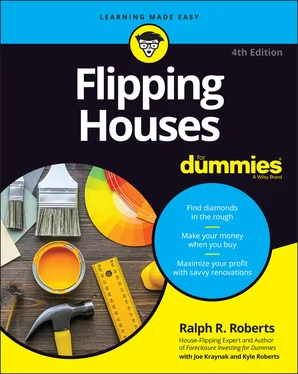Ralph R. Roberts - Flipping Houses For Dummies
Здесь есть возможность читать онлайн «Ralph R. Roberts - Flipping Houses For Dummies» — ознакомительный отрывок электронной книги совершенно бесплатно, а после прочтения отрывка купить полную версию. В некоторых случаях можно слушать аудио, скачать через торрент в формате fb2 и присутствует краткое содержание. Жанр: unrecognised, на английском языке. Описание произведения, (предисловие) а так же отзывы посетителей доступны на портале библиотеки ЛибКат.
- Название:Flipping Houses For Dummies
- Автор:
- Жанр:
- Год:неизвестен
- ISBN:нет данных
- Рейтинг книги:3 / 5. Голосов: 1
-
Избранное:Добавить в избранное
- Отзывы:
-
Ваша оценка:
- 60
- 1
- 2
- 3
- 4
- 5
Flipping Houses For Dummies: краткое содержание, описание и аннотация
Предлагаем к чтению аннотацию, описание, краткое содержание или предисловие (зависит от того, что написал сам автор книги «Flipping Houses For Dummies»). Если вы не нашли необходимую информацию о книге — напишите в комментариях, мы постараемся отыскать её.
Flipping Houses For Dummies
Flipping Houses For Dummies
Flipping Houses For Dummies
Flipping Houses For Dummies — читать онлайн ознакомительный отрывок
Ниже представлен текст книги, разбитый по страницам. Система сохранения места последней прочитанной страницы, позволяет с удобством читать онлайн бесплатно книгу «Flipping Houses For Dummies», без необходимости каждый раз заново искать на чём Вы остановились. Поставьте закладку, и сможете в любой момент перейти на страницу, на которой закончили чтение.
Интервал:
Закладка:
To gauge their confidence in approving a loan, lenders look at your five Cs: collateral, character, credit, confidence, and cash flow:
Collateral is the property you intend to purchase. When you’re flipping houses and attempting to obtain loan approval before looking at houses, you’re not in a position to describe the collateral, but you can put together a plan that shows the price ranges of the houses you intend to purchase, appreciation percentages for the area, and how you plan to renovate and sell the properties for a profit.
Character is the way you present yourself to the lender. You need to convince the lender that you have the knowledge and resources available to profit from your investments. A strong plan and presentation can convince the lender that you have the right stuff.
Credit is your credit report, credit score, and credit worthiness (how much you can afford). A clean credit report shows that you pay your bills and aren’t over your head in debt. See “ Checking and correcting your credit report,” later in this chapter.
Confidence is how strongly you and the lender believe that you can deliver what you promise. Pitching a solid plan can build the lender’s confidence. How you portray your project either gives the lender confidence in your abilities or sends the lender running to the hills.
Cash flow is your current monthly income minus your monthly expenses — the amount of money you have free each month to take on your project. Consistently having significantly more monthly income than monthly expenses shows lenders that you’re a competent money manager and can afford loan payments of a certain amount.
Before approaching a prospective lender, do your homework and draw up a business plan showing that you know what you’re doing. Here are a few ideas on how to proceed:
Show the prospective lender a sample of a property that someone else recently flipped in the area — for example, a property that the person bought for $80,000 on August 8 and sold for $146,000 on November 16. Persuade the lender, through your knowledge and enthusiasm, that you can do the same.
Present a property you would purchase now if you had the money and explain how you would fix it up and sell it.
Tie up a property on paper (either through a purchase agreement or an option to buy) and present this property as an opportunity. It sounds risky, but it often works, and it forces you to find the money to close on the deal! (Your agent or attorney can help you with the necessary paperwork.)
If you’re not comfortable drawing up a plan yourself, ask your agent and attorney for help. They can assist you in creating a plan and point you in the direction of other lending institutions and private investors they know.
 If at first you don’t succeed, try, try again. If a lender rejects your proposal or gives you the cold shoulder, figure out why, change your package or presentation, and give it another shot. When I first started, a lender rejected my loan request on the grounds that I didn’t have enough experience. I added my father, an experienced carpenter and builder, to my proposal and pitched it to the same lender, who eventually loaned me the money I needed. My perspective has always been that “no” means the person I’m dealing with doesn’t “know” enough information to say yes.
If at first you don’t succeed, try, try again. If a lender rejects your proposal or gives you the cold shoulder, figure out why, change your package or presentation, and give it another shot. When I first started, a lender rejected my loan request on the grounds that I didn’t have enough experience. I added my father, an experienced carpenter and builder, to my proposal and pitched it to the same lender, who eventually loaned me the money I needed. My perspective has always been that “no” means the person I’m dealing with doesn’t “know” enough information to say yes.
Passing the hat among friends and family
Charity should begin at home. If you have a rich Auntie Ellen who has a stash of cash she’s willing to invest and you don’t mind calling in some favors, hit her up for the money. With family members, you may be able to secure a short-term, no-interest loan, assuming that you’re not considered the black sheep of the family.
GRANNY AND ME
My first real estate investment partner was my grandmother. She put up the money, and I did the rest. We made a deal — every time I sold a house, I had to take her out for lunch. We measured our success in how frequently we had lunch together.
Partnering with friends or family members can be one of the most fulfilling experiences, but when it comes to money, friends and family can be more brutal than bankers, especially if your flip flops. In most cases, I generally discourage investors from taking on a partner, especially family members, but with Granny and me, the partnership turned out to be a rewarding experience for both of us.
 Be careful borrowing from friends or family members. A flip that flops can quickly turn family members and friends against one another when money is lost and loans can’t be repaid. Be clear upfront about what’s at stake and the risks involved. Don’t risk losing a close relationship over a real estate deal gone bad.
Be careful borrowing from friends or family members. A flip that flops can quickly turn family members and friends against one another when money is lost and loans can’t be repaid. Be clear upfront about what’s at stake and the risks involved. Don’t risk losing a close relationship over a real estate deal gone bad.
Borrowing from a private (hard money) lender
Lots of people have money to invest and are disenchanted with interest rates offered by banks and even the returns on their stocks and bonds. Convince them of your ability to turn a profit from flipping properties, and they just may loan you the capital you need to get started.
Loans from private lenders are often referred to as hard money loans — high-interest loans that typically require an upfront payment and scheduled balloon (lump sum) payments. The property and any future improvements function as collateral for the loan.
The big benefit to hard money loans is that you avoid the hassles associated with traditional bank loans. In fact, you can often qualify for a hard money loan when you can’t qualify for traditional loans. But it’s called hard money for a reason — actually, for several reasons:
Hard money lenders don’t care as much about your personal income and expenses or your credit score. They want to know that if you default on the loan, they get a property they can sell for 20 to 40 percent or more than what you borrowed.
As the borrower, you typically pay two to ten points up front — money you’ll never see again — so if you borrow $200,000, you can expect to pay $4,000 to $20,000 up front, just for the privilege of gaining access to cash.
Private lenders charge much higher interest rates than banks do — sometimes double or triple what banks charge — so if bank loans are at 4 percent, you might be paying a private lender 8 to 12 percent. Private lenders can charge these high rates because they’re loaning money to you as an investment opportunity. If you were living in the property, private lenders couldn’t charge you these rates. Lending at those rates is considered to be usury, which is illegal (unless you’re a major credit card company).
You have significantly less time to pay off the loan — a few months to a few years, as opposed to traditional mortgage loans with payback periods of 15 to 30 years. If you can’t sell the property or refinance the loan by the deadline, you risk losing the property.
Hard money typically requires a larger down payment than traditional bank loans — 10 to 20 percent or more — so if the property has a current market value of $200,000, the maximum you can borrow is $160,000 to $180,000. You need to come up with the other $20,000 to $40,000 yourself, along with money to cover holding costs and the costs of repairs and renovations. (See the next section for info about gap loans, which can help you make up the difference.)
You may be required to make scheduled balloon payments over the term of the loan. Miss a payment, and you risk losing the property.
Читать дальшеИнтервал:
Закладка:
Похожие книги на «Flipping Houses For Dummies»
Представляем Вашему вниманию похожие книги на «Flipping Houses For Dummies» списком для выбора. Мы отобрали схожую по названию и смыслу литературу в надежде предоставить читателям больше вариантов отыскать новые, интересные, ещё непрочитанные произведения.
Обсуждение, отзывы о книге «Flipping Houses For Dummies» и просто собственные мнения читателей. Оставьте ваши комментарии, напишите, что Вы думаете о произведении, его смысле или главных героях. Укажите что конкретно понравилось, а что нет, и почему Вы так считаете.












